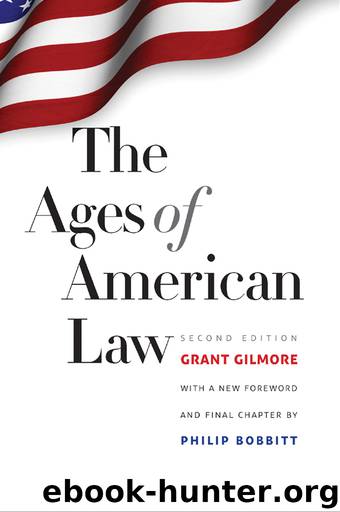The Ages of American Law by Grant Gilmore

Author:Grant Gilmore [Gilmore, Grant]
Language: eng
Format: epub
Publisher: Yale University Press
Published: 1977-10-23T16:00:00+00:00
Notes
FOREWORD
1. The situation reminded me of the not wholly dissimilar case of Strunk and White. Will Strunk was a legendary English professor at Cornell University who, in 1919, privately published The Elements of Style for college students whose essay writing could benefit from some pruning of late nineteenth-century fussiness and overelaboration. One of Strunk’s students was “Andy” White (apparently all red-headed students at Cornell in those times were called “Andy” after the founder), whose New Yorker pieces and children’s books earned him immortality as E. B. White. Macmillan publishers commissioned White to revise the text for a 1959 edition (Strunk had died some years earlier), and the happy result perpetuated Strunk’s devotion to “cleanliness, accuracy and brevity in the use of En glish.” I held Gilmore in very high regard, as White had held Will Strunk, and I generally agreed with his ironic skepticism toward the various movements that, from time to time, mesmerized the American legal academy with their promises of salvation.
2. R. Cover, Justice Accused, at 200 (1975).
3. Id. at 229.
4. Indeed I mainly remember one particular lunch. After going back and forth for an hour, Gilmore patiently explaining why I should choose a more manageable research agenda, I wriggling loose, I had devoured another hamburger and Gilmore had drained his martini. He looked at me steadily, with his slightly crossed eyes through thick glasses, and said in his flinty, rock-ribbed accent, “Mr. Bobbitt, you are like the grasshopper [as Gilmore pronounced the word, it would have been rendered ‘grawshop′pah’]. You’re here, you’re there, but I cannot pin you down.” I realized this wasn’t a compliment, and I slipped away from Morey’s; Gilmore, perhaps in despair, stayed for a second martini. As I walked down York Street, I passed the windows of J. Press, in which a tie caught my eye, a tie with grasshoppers. I still have it.
5. 84 Yale L. J. 1022–1044 (Apr. 1975).
6. The final paragraph of my book Terror and Consent concludes with an homage to Gilmore in the form of a reworking of the final paragraph of The Ages of American Law.
PREFACE
1. The concluding lecture in the series was published, substantially in the form in which it was delivered (with the addition of a few footnotes), in the Yale Law Journal under the title “The Age of Anxiety” (84 Yale L. J. 1022 (1975)). The material covered in that lecture now appears as Chapters 4 and 5.
CHAPTER 1
1. S.F.C. Milsom, Historical Foundations of the Common Law xi (1969).
2. The entries under the heading “jurisprudence” in the New Oxford Dictionary suggest that the first uses of the word to mean “philosophy of law” date from the nineteenth century. In earlier English usage the word had referred to legal systems generally or to their study.
3. There will, perhaps, be general agreement that economics and sociology were eighteenth-century inventions. My suggestion that history was another may seem, at first blush, surprising, since historical writing in the Western intellectual tradition goes back at least to the Greeks and Romans.
Download
This site does not store any files on its server. We only index and link to content provided by other sites. Please contact the content providers to delete copyright contents if any and email us, we'll remove relevant links or contents immediately.
2010-The City & the City by China Miéville(1518)
Anatomy of Injustice by Raymond Bonner(1268)
ADHD on Trial by Michael Gordon(1239)
That Every Man Be Armed by Stephen P. Halbrook(1237)
Injustices by Ian Millhiser(1199)
You Don't Own Me by Orly Lobel(1145)
Tell by Major Margaret Witt(1100)
A Vast Conspiracy by Jeffrey Toobin(1065)
Course Correction by Ginny Gilder(1046)
Broken Scales by Joel Cohen(1016)
First by Evan Thomas(990)
Without Copyrights by Spoo Robert(978)
J by Howard Jacobson(976)
The Run of His Life: The People v. O. J. Simpson by Jeffrey Toobin(960)
A Religious Orgy in Tennessee by H.L. Mencken(950)
A Triumph of Genius: Edwin Land, Polaroid, and the Kodak Patent War by Ronald K. Fierstein(902)
A History Of Thailand by Baker Chris(890)
Law 101: Everything You Need to Know About American Law, Fourth Edition by Jay Feinman(849)
John Wayne Gacy by Judge Sam Amirante(845)
